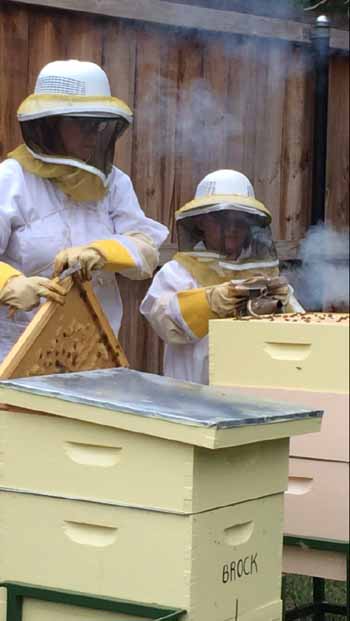Jen Brock
Busy Bees with Jen Brock
Story by Kathryn R. Burke
 [Ouray, Colo., January 16, 2018] Bees are our friends. Bees produce honey, the only food source that never goes bad. Bees pollinate, a process that can produce a healthy garden with a bountiful crop.
[Ouray, Colo., January 16, 2018] Bees are our friends. Bees produce honey, the only food source that never goes bad. Bees pollinate, a process that can produce a healthy garden with a bountiful crop.
Bees have an enviable communication system with the plants they pollinate and are proof that the animal kingdom communicates with the plant kingdom. Through a form of electromagnetic information transfer, bees know when a plant is loaded with pollen—and when it isn’t. They will fly up to six miles to partake of your garden, if it’s pollen-ready. Or visit someone else’s when yours is light on pollen.
Bees practice climate control, and did that before we ever even heard of the term. (Although how they do it could be considered a bit radical.) In hot weather, rapidly fanning wings can cool the hive. In the dead of winter, they bundle up, and a few selfless insects self-combust to keep the hive warm.
 Bees have a social structure and business organization that we could all take lessons from. A typical, healthy hive has 50-60 thousand honey bees in residence, with one Queen Bee, and a harem of worker bees holding various roles from warrior to nurse. Architects make the comb and comb cleaners keep it clean. Undertakers remove the dead.
Bees have a social structure and business organization that we could all take lessons from. A typical, healthy hive has 50-60 thousand honey bees in residence, with one Queen Bee, and a harem of worker bees holding various roles from warrior to nurse. Architects make the comb and comb cleaners keep it clean. Undertakers remove the dead.
Bees don’t need unemployment insurance or care for the aged. Worker bees, which comprise the bulk of the bee population, live about six weeks, not surprising when you consider how busy they are keeping the hive alive and highly productive. They are truly ‘busy bees.’
Bees also practice an interesting form of birth control. The Queen Bee mates 5-30 times with drones (from other hives) that hangout together, waiting for their big opportunity. Alas, once their semen is ejected, the process rips their innards out and they die. The Queen Bee gathers up the sperm from her sperm donors, stores it in her semen pouch, and after her one venture into the mating game, turns celibate and lays eggs, to the tune of 1,500-2,000 a day. Queens live two to five years; that’s a lot of eggs. Nurse worker bees take care of the eggs, which morph into larvae before a bee is born, fully grown—99.9% of them are female. Even with that many eggs, the Bee population is shrinking. Why?
Bees are vulnerable. Due to chemical pesticides, herbicides, and fertilizers, bees are dying off at catastrophic levels: 30 to 40 percent a year. Today’s bee population is half of what it was in 1945. Continue killing honey bees with chemicals, and they will be gone, taking some of our most important food sources with them: honey, and produce—as in fruits and vegetables. Picture the world without strawberries. Or apples. They’ll go when the bees go.
All this information, and more, comes courtesy of Jen Brock of Ouray, Colorado. Brock is a hobbyist Bee Keeper. She has two hives in her home state of Texas, and those hives produce enough honey to keep her family supplied. “Bees don’t need a lot of care,” she explains, “so I only visit them a few times a year to check on them. A couple times a year is pretty intense—fall and spring. Think of it as being like the time period for gardening. Plant in the spring, harvest in the fall.” And all the while between checks and during checks, the bees are busy.
Photographs, courtesy Jen Brock.
This article also appears on website for the Woman’s Club of Ouray County. Designed and maintained by Kathryn R. Burke.

